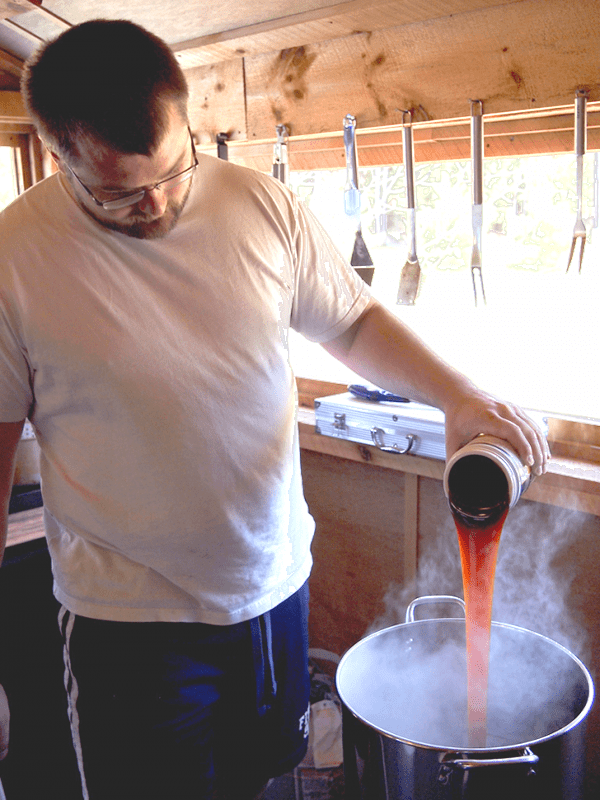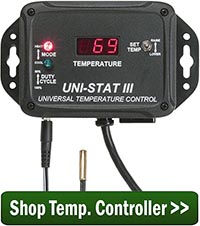 A common issue among beginning extract and partial mash homebrewers is that they undershoot their beer recipe’s anticipated original gravity. The original gravity is too low. This can happen for a number of reasons when beer brewing, but largely because many homebrew kits call for topping off with water to get five gallons of wort, without taking into account how the brew day went. (What if you spilled some wort or didn’t get all the extract out of the can?) This can throw off alcohol content, mouthfeel, IBUs – in short, turning the beer into something it wasn’t supposed to be. That’s not to say that it won’t be completely drinkable – it may well be. But some of us, for better or worse, are perfectionists.
A common issue among beginning extract and partial mash homebrewers is that they undershoot their beer recipe’s anticipated original gravity. The original gravity is too low. This can happen for a number of reasons when beer brewing, but largely because many homebrew kits call for topping off with water to get five gallons of wort, without taking into account how the brew day went. (What if you spilled some wort or didn’t get all the extract out of the can?) This can throw off alcohol content, mouthfeel, IBUs – in short, turning the beer into something it wasn’t supposed to be. That’s not to say that it won’t be completely drinkable – it may well be. But some of us, for better or worse, are perfectionists.
The best time for extract brewers to correct for gravity is right after the boil. Take a hydrometer reading before pitching the beer yeast to get your bearings. Plug your numbers into a dilution calculator to see if topping up to five gallons will get you to your target OG. If you think you’ll end up with the original gravity too low, read the tips below:
- Double-check your OG (original gravity) reading. Did you take the reading at the calibrated temperature for your hydrometer (usually 60˚F or 68˚F)? If not, did you correct for temperature using a hydrometer temperature correction calculator? Taking a reading out of the temperature range or failing to correct for temperature can throw off your reading by several points.
- Decide how you want to move forward. You have a few options here. Do you want to just go with what you’ve got? Do you want a full five gallon batch of beer? If you top off the wort to a full five gallons, you’ll have a lower alcohol beer than what you expected. If you only top off with enough water to hit your target original gravity, you’ll end up with less beer, but at least have the correct original gravity and alcohol content. Alternatively, you can mix in more fermentables in order to meet both your original gravity and your target batch volume.

- To hit your target volume, top off to five gallons. You’ll have a slightly weaker beer than intended, but this might be a worthwhile sacrifice for the sake of more beer. Trust me, I understand.
- To hit your target original gravity, top off to less than five gallons. Use a dilution calculator to figure out how much water to add so that you can hit your target gravity. You can also do the math by hand pretty easily. For example, if your three gallons of wort is 1.060 and your intended gravity is 1.040, plug in the numbers and solve for the volume of water (A2):
A1*B1 + A2*B2 = (A1+A2)*(target gravity)
(3 gallons at 60 gravity points) + (A2 gallons at 0 gravity points [water]) = (3 + A2) gallons at 40 gravity points
A2 = 1.5 gallons
- To hit your target volume and your target gravity, you can mix in more fermentables. Some may consider this the ultimate way to go when the original gravity is too low. Using the blending formula above, you can figure out how much additional fermentable ingredients you need. Mix up a small batch (about one-half to one gallon) of concentrated wort using DME (dried malt extract), sugar, honey, or molasses. Your fermentable ingredient will depend on your beer recipe and what you have on hand. DME will be the most beer-like, while excessive sugars may cause your beer to over attenuate. Dark DME or molasses may alter the color of your beer, so choose wisely. If you can, boil enough hops in the mini batch to maintain your level of IBUs.
Let’s work through an example.
My target OG was 1.052. Instead, I ended up with 4.5 gallons at 1.044. This is a much lower than expected original gravity. My measured IBUs (after dilution with water) was 30. First let’s figure out how much additional fermentable I need in a half-gallon mini-batch to hit my target OG:
(4.5 gallons * 44) + (0.5 gallons * X) = 5 gallons * 52
X = 124
To get a gravity of 1.124, my half-gallon batch needs about 1.48 lbs. of DME, 1.35 lbs. of cane sugar, or 1.48 lbs. of honey. (A beer recipe calculator can help you figure this out.)
About .3 ounces of a 5% alpha acid hop boiled for thirty minutes will yield about 30 IBUs in the mini-batch. You don’t necessarily have to add hops to the mini-batch, but it will keep you from diluting the bitterness of your beer.
Sure, it gets a little complicated. Most of the time when your original gravity is too low, you may just want to roll with whatever gravity you get. Here’s some tips for hitting your original gravity. But in the event that you need to make some adjustments, learning how to execute the above procedures is crucial for dealing with a lower than expected original gravity.
—–
David Ackley is a beer writer, brewer, and self-described “craft beer crusader.” He holds a General Certificate in Brewing from the Institute of Brewing and Distilling and is founder and editor of the Local Beer Blog.

Chaps, I consistently admire the articles you post to google. I often struggle with the OG vs. correct volume question. Often the boil of the wort will cause a loss of up to 1/3 gallon (approx. 3 litres) to evaporation depending on the climatic conditions at the time and the rate of boil. I aim for a rolling boil which means I need to expose the surface of the wort to avoid a boil over situation. This article will help me adjust.
I didn’t take my O.G. This is my very first batch and totally forgot. now it has been a week of fermenting. What do I do????? Please Help.
AJ, below we have posted the link to another article from our website that contains a link to some calculators that may assist you in determining the original gravity. When you click on the calculator link in the article look for the one for original gravity. Which calculator you choose depends on if you are extract or all grain brewing. We hope this helps.
Brew Calculators
http://www.eckraus.com/blog/taking-advantage-of-beer-brewing-stats-and-calculators
Just came across this article. Very helpful! I’ve been brewing about 7-8 5 gal batches per year for a few years and have just rolled with the weaker beer. Two undrinkable batches so far. Thank you!
Dale